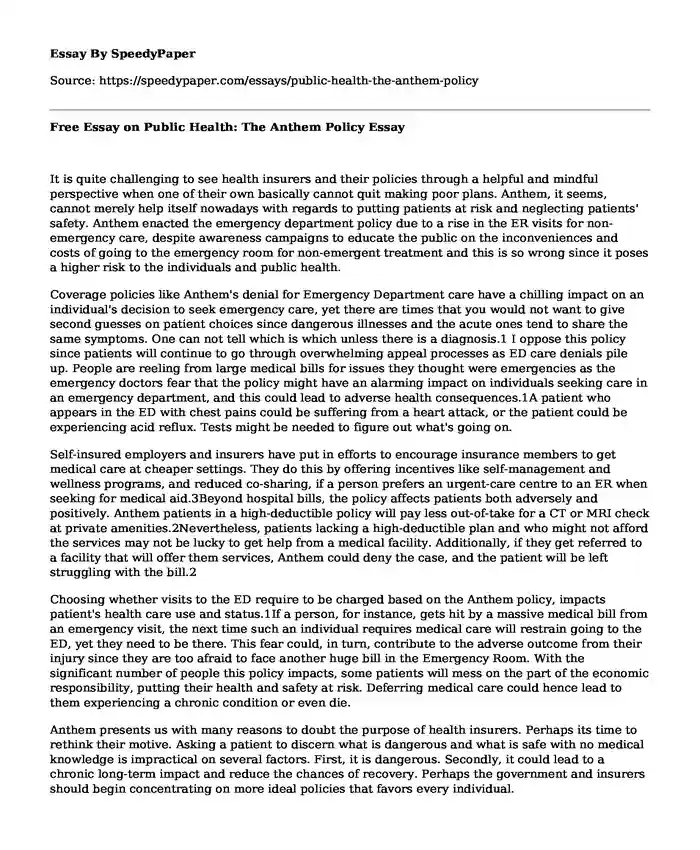
| Type of paper: | Essay |
| Categories: | Healthcare policy Public health |
| Pages: | 3 |
| Wordcount: | 679 words |
It is quite challenging to see health insurers and their policies through a helpful and mindful perspective when one of their own basically cannot quit making poor plans. Anthem, it seems, cannot merely help itself nowadays with regards to putting patients at risk and neglecting patients' safety. Anthem enacted the emergency department policy due to a rise in the ER visits for non-emergency care, despite awareness campaigns to educate the public on the inconveniences and costs of going to the emergency room for non-emergent treatment and this is so wrong since it poses a higher risk to the individuals and public health.
Coverage policies like Anthem's denial for Emergency Department care have a chilling impact on an individual's decision to seek emergency care, yet there are times that you would not want to give second guesses on patient choices since dangerous illnesses and the acute ones tend to share the same symptoms. One can not tell which is which unless there is a diagnosis.1 I oppose this policy since patients will continue to go through overwhelming appeal processes as ED care denials pile up. People are reeling from large medical bills for issues they thought were emergencies as the emergency doctors fear that the policy might have an alarming impact on individuals seeking care in an emergency department, and this could lead to adverse health consequences.1A patient who appears in the ED with chest pains could be suffering from a heart attack, or the patient could be experiencing acid reflux. Tests might be needed to figure out what's going on.
Self-insured employers and insurers have put in efforts to encourage insurance members to get medical care at cheaper settings. They do this by offering incentives like self-management and wellness programs, and reduced co-sharing, if a person prefers an urgent-care centre to an ER when seeking for medical aid.3Beyond hospital bills, the policy affects patients both adversely and positively. Anthem patients in a high-deductible policy will pay less out-of-take for a CT or MRI check at private amenities.2Nevertheless, patients lacking a high-deductible plan and who might not afford the services may not be lucky to get help from a medical facility. Additionally, if they get referred to a facility that will offer them services, Anthem could deny the case, and the patient will be left struggling with the bill.2
Choosing whether visits to the ED require to be charged based on the Anthem policy, impacts patient's health care use and status.1If a person, for instance, gets hit by a massive medical bill from an emergency visit, the next time such an individual requires medical care will restrain going to the ED, yet they need to be there. This fear could, in turn, contribute to the adverse outcome from their injury since they are too afraid to face another huge bill in the Emergency Room. With the significant number of people this policy impacts, some patients will mess on the part of the economic responsibility, putting their health and safety at risk. Deferring medical care could hence lead to them experiencing a chronic condition or even die.
Anthem presents us with many reasons to doubt the purpose of health insurers. Perhaps its time to rethink their motive. Asking a patient to discern what is dangerous and what is safe with no medical knowledge is impractical on several factors. First, it is dangerous. Secondly, it could lead to a chronic long-term impact and reduce the chances of recovery. Perhaps the government and insurers should begin concentrating on more ideal policies that favors every individual.
Reference List
Smulowitz PB, Friedman AB, Pines JM. Appropriations for "appropriate" visits: Payment denials for emergency department care. The American journal of emergency medicine. 2018 Aug 1;36(8):1511-2. doi:https://doi.org/10.1016/j.ajem.2017.12.061
Kliff, S. An ER Visit, a $12,000 bill - and a Health Insurer that Wouldn't Pay. Vox.com.https://www.vox.com/policy-and-politics/2018/1/29/16906558/anthem-emergency-room- coverage-denials-inappropriate. Accessed August 7, 2018.
Baicker K and Chandra A. The Veiled Economics of Employee Cost-Sharing. JAMA Intern Med. 2015; 175 (7):1081-2. http://vbidcenter.org/wp-content/uploads/2015/05/6-JAMA_The-Veiled-Economics-of-Employee-Cost-Sharing-JAMA.pdf. Accessed October 12, 2018.
Cite this page
Free Essay on Public Health: The Anthem Policy. (2022, Sep 12). Retrieved from https://speedypaper.com/essays/public-health-the-anthem-policy
Request Removal
If you are the original author of this essay and no longer wish to have it published on the SpeedyPaper website, please click below to request its removal:
- Free Essay: Jonathan Livingstone Seagull and Allegory of the Cave
- Essay Example on Communication of Emotions
- Essay Example Dedicated to McDonald's
- Human Nutrition Paper Sample
- Free Essay with a Proposal about College Issue
- Free Essay on Drugs and Effects on Body
- Free Essay Sample on Post-Trauma Stress Disorder Management
Popular categories




